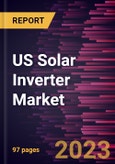The US solar inverter market is projected to reach US$ 825.86 million in 2022 and is expected to reach US$ 2,773.99 million by 2030; it is estimated to record a CAGR of 14.8% from 2022 to 2030.
Solar installations attributed to government-led incentives and schemes, along with growing residential solar rooftop installations, positively influence the solar PV inverters market growth. Further, the increasing investments in the renewable energy sector to reduce fossil fuel consumption to lower carbon emission, coupled with technological innovations in US solar inverter market, are among the factors driving the market growth. However, the safety risks associated with high DC voltages in solar inverters are restraining the market growth.
A string inverter is connected to a solar array (a string of solar panels) to convert the direct current (DC) to usable electricity (alternating current) for residential and commercial applications. One string inverter can handle energy produced from a row of 5-10 solar panels.
The need for US solar inverter market was prevalent during the pre-COVID-19 era because of the growing urban population that led to increasing infrastructural developments. Due to the COVID-19 pandemic, the outlook for solar energy changed dramatically. In June 2020, the solar industry employed 188,000 workers rather than the 302,000 originally forecasted - a sharp decline of 38% was observed. The US planned to install 3 gigawatts (GW) of solar capacity in Q2 2020 - a 37% decline from pre-COVID forecasts. In Q2 of 2020, the US solar deployment project witnessed a drop-off equivalent to power 288,000 homes, i.e., US$ 3.2 billion in economic investment. In 2020, manufacturing industries were severely affected due to a drastic decrease in product demand, falling prices, and storage shortages. A swift decline in manufacturing revenues due to virtually nonexistent manufacturing demand and slow production capabilities limited the expenditure on installing or upgrading existing solar inverters across various industries in North America. Periodic maintenance and discontinuation of operation in existing manufacturing plants also hampered the demand for US solar inverter market. Thus, the COVID-19 pandemic adversely affected the US solar inverter market growth.
In 2021, private companies invested in distributed (including rooftop) solar PV installation on residential buildings. This type of investment created a demand for solar Inverters. The manufacturing industry started recovering from labor shortages and supply chain challenges, which triggered the adoption of US solar inverter market. In 2022, solar inverters witnessed a higher demand in the US due to the continued progress in the renewable energy sector.
GoodWe Technologies Co Ltd, Delta Electronics Inc, CyboEnergy Inc, Yaskawa America Inc, Danfoss AS, SMA Solar Technology AG, SolarEdge Technologies Inc, Power Electronics SL, Ginlong Technologies Co Ltd, Chicago Digital Power Inc, Sungrow Power Supply Co Ltd, Caterpillar Inc. are a few key US solar inverter market players.
The consumption of renewable energy sources in the US is on the rise, with wind and solar energy contributing 14% of domestic electricity production. In March 2022, electricity generated from renewables surpassed coal. Hydropower contributed 6%, and biomass and geothermal sources generated less than 1%. California produced 26% of the national utility-scale solar electricity, followed by Texas with 16% and North Carolina with 8%. Texas also led the way in wind generation, accounting for 26% of the US. Iowa and Oklahoma were the next closest states, with 10% and 9% of the total, respectively. Thus, the surge in the transition from nonrenewable sources to renewable sources to meet growing energy consumption requirements is expected to continue to create lucrative opportunities for the US solar inverter market players during the forecast period.
Table of Contents
Companies Mentioned (Partial List)
A selection of companies mentioned in this report includes, but is not limited to:
- GoodWe Technologies Co Ltd
- Delta Electronics Inc
- CyboEnergy Inc
- Yaskawa America Inc
- Danfoss AS
- SMA Solar Technology AG
- SolarEdge Technologies Inc
- Power Electronics SL
- Chicago Digital Power Inc
- Sungrow Power Supply Co L
Table Information
| Report Attribute | Details |
|---|---|
| No. of Pages | 97 |
| Published | August 2023 |
| Forecast Period | 2022 - 2030 |
| Estimated Market Value ( USD | $ 825.86 million |
| Forecasted Market Value ( USD | $ 2773.99 million |
| Compound Annual Growth Rate | 14.8% |
| Regions Covered | United States |









